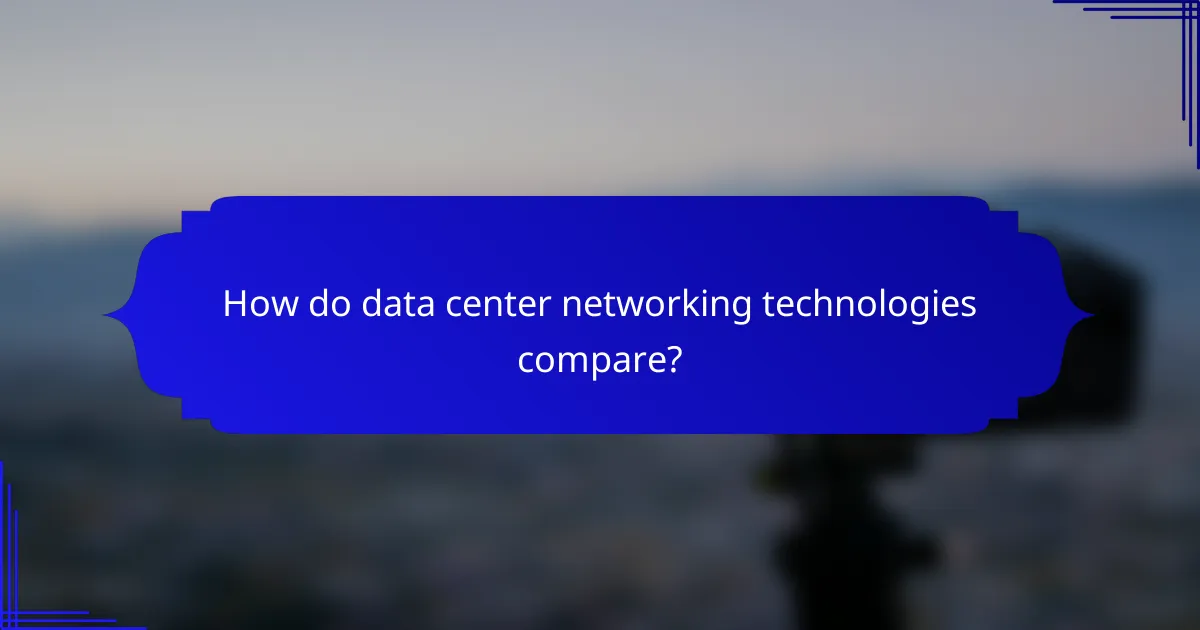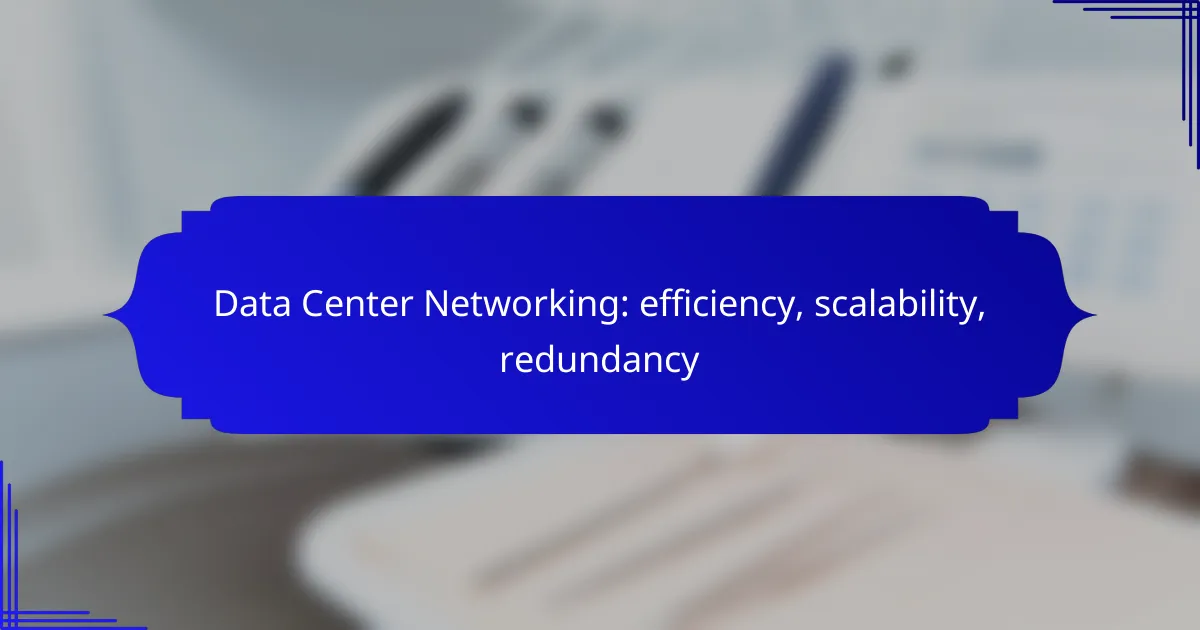Data center networking is crucial for optimizing performance and cost-effectiveness in modern IT infrastructures. By leveraging advanced technologies such as software-defined networking and network function virtualization, organizations can enhance efficiency while ensuring scalability through modular designs and cloud solutions. Additionally, implementing redundancy strategies is essential to maintain operations during failures, thereby improving overall reliability and uptime.

How to improve data center networking efficiency in New Zealand?
Improving data center networking efficiency in New Zealand involves adopting modern technologies and practices that enhance performance while reducing costs. Key strategies include implementing software-defined networking, utilizing network function virtualization, and optimizing bandwidth management.
Implementing software-defined networking
Software-defined networking (SDN) separates the control plane from the data plane, allowing for centralized management of network resources. This flexibility enables quicker adjustments to network configurations, which can lead to significant improvements in efficiency.
In New Zealand, organizations can benefit from SDN by automating network provisioning and reducing the time needed for changes. This can help in managing peak loads more effectively, ensuring that resources are allocated where they are most needed.
Utilizing network function virtualization
Network function virtualization (NFV) allows data centers to run network services on virtual machines instead of dedicated hardware. This approach can lead to reduced capital expenditures and operational costs, as it minimizes the need for physical devices.
For New Zealand data centers, adopting NFV can enhance scalability and flexibility. By deploying virtualized network functions, organizations can quickly scale services up or down based on demand, which is particularly useful during high-traffic periods.
Optimizing bandwidth management
Effective bandwidth management ensures that network resources are used efficiently, preventing bottlenecks and improving overall performance. Techniques include traffic shaping, prioritizing critical applications, and monitoring usage patterns.
In New Zealand, data centers should regularly analyze bandwidth consumption to identify trends and adjust allocations accordingly. Implementing quality of service (QoS) policies can help prioritize essential services, ensuring they receive the necessary bandwidth during peak usage times.

What are the best practices for scalability in data center networking?
To achieve scalability in data center networking, organizations should focus on modular designs, cloud solutions, and hardware that can grow with demand. These practices ensure that networks can efficiently adapt to increasing loads without significant downtime or reconfiguration.
Adopting modular network architectures
Modular network architectures allow for incremental growth by adding new components as needed. This approach reduces the need for complete overhauls when expanding capacity, making it both cost-effective and efficient. For instance, using a spine-leaf architecture can facilitate easy scaling by simply adding more spine switches to handle increased traffic.
When implementing a modular design, consider the potential for future growth and ensure that each module can operate independently. This independence allows for maintenance or upgrades without disrupting the entire network.
Leveraging cloud-based solutions
Cloud-based solutions provide flexibility and scalability by allowing organizations to adjust resources based on current demands. Utilizing Infrastructure as a Service (IaaS) can help businesses avoid over-provisioning and reduce costs, as they only pay for what they use. This is particularly beneficial for fluctuating workloads, such as during peak business seasons.
However, it is essential to choose a reliable cloud provider that meets compliance and performance standards. Evaluate factors like latency, data transfer costs, and service level agreements (SLAs) to ensure that the cloud solution aligns with your scalability goals.
Using scalable hardware components
Investing in scalable hardware components is crucial for accommodating growth in data center networking. Look for switches, routers, and servers that can support higher capacities without requiring complete replacement. For example, network switches that support stacking can easily expand bandwidth as needed.
Additionally, consider hardware that supports virtualization, allowing multiple workloads to run on a single physical device. This can optimize resource usage and reduce the total number of devices needed, which simplifies management and lowers operational costs.

How to ensure redundancy in data center networks?
To ensure redundancy in data center networks, implement strategies that provide backup connections and systems to maintain operations during failures. This involves using multiple pathways and components to prevent single points of failure, thereby enhancing reliability and uptime.
Implementing dual-homed connections
Dual-homed connections involve connecting a network device to two different upstream providers or switches. This setup ensures that if one connection fails, the other can take over, maintaining network availability. It’s essential to configure routing protocols to recognize and utilize both paths effectively.
Consider using Ethernet or fiber connections for dual-homing, as they typically offer higher bandwidth and lower latency. Regularly test these connections to ensure they are functioning correctly and can handle the expected traffic load.
Using load balancers for traffic distribution
Load balancers distribute incoming network traffic across multiple servers, ensuring no single server becomes overwhelmed. This not only enhances performance but also provides redundancy; if one server fails, the load balancer reroutes traffic to operational servers. Implementing this can significantly improve user experience and system reliability.
Choose between hardware and software load balancers based on your data center’s needs. Hardware solutions often provide better performance, while software options offer flexibility and lower costs. Regularly monitor the load balancer’s performance to optimize traffic distribution and detect any issues promptly.
Establishing failover protocols
Failover protocols are essential for maintaining service continuity during outages. These protocols automatically switch to backup systems when the primary system fails, minimizing downtime. Common failover strategies include active-passive and active-active configurations, each with its own advantages and trade-offs.
When implementing failover protocols, ensure that all systems are synchronized and that data integrity is maintained. Regularly test these protocols to confirm they function as intended during an actual failure scenario, and update them as necessary to adapt to changing network conditions.

What criteria should be considered when choosing data center networking solutions?
When selecting data center networking solutions, it’s essential to consider efficiency, scalability, and redundancy. These factors directly impact the performance, reliability, and future growth potential of your network infrastructure.
Assessing current and future bandwidth needs
Understanding your current and anticipated bandwidth requirements is crucial for selecting the right networking solution. Analyze your existing traffic patterns and project future growth based on business needs and technological advancements.
Consider factors such as the number of users, types of applications, and data transfer volumes. A good rule of thumb is to plan for at least a 30-50% increase in bandwidth capacity over the next few years to accommodate growth.
Evaluating vendor reliability and support
Choosing a reliable vendor is vital for ensuring ongoing support and maintenance of your networking solutions. Research vendor reputation, customer reviews, and case studies to gauge their reliability in the market.
Additionally, assess the level of technical support offered, including response times and availability. Opt for vendors that provide comprehensive service level agreements (SLAs) to ensure your network remains operational with minimal downtime.

How do data center networking technologies compare?
Data center networking technologies vary significantly in terms of efficiency, scalability, and redundancy. Understanding these differences is crucial for optimizing performance and ensuring reliable operations in data centers.
Comparing Ethernet vs. InfiniBand
Ethernet and InfiniBand are two primary networking technologies used in data centers, each with distinct advantages. Ethernet is widely adopted due to its cost-effectiveness and compatibility with existing infrastructure, while InfiniBand excels in high-performance computing environments, offering lower latency and higher throughput.
When choosing between the two, consider the specific needs of your applications. For general data center operations, Ethernet is often sufficient, but for tasks requiring rapid data processing, such as machine learning or large-scale simulations, InfiniBand may be the better choice.
Evaluating traditional vs. cloud networking
Traditional networking involves on-premises hardware and management, while cloud networking leverages virtualized resources and services. Cloud networking offers greater scalability and flexibility, allowing organizations to adjust resources based on demand without significant upfront investment.
However, traditional networking can provide more control and potentially lower latency for specific applications. Organizations should assess their workload requirements, budget constraints, and growth projections to determine the most suitable networking approach.

What are the emerging trends in data center networking?
Emerging trends in data center networking focus on enhancing efficiency, scalability, and redundancy. Key developments include the integration of AI technologies, the rise of edge computing, and a heightened emphasis on cybersecurity measures.
Adoption of AI-driven network management
AI-driven network management is transforming data center operations by automating routine tasks and optimizing performance. These systems analyze vast amounts of network data to predict issues, manage traffic, and enhance resource allocation.
For example, AI can automatically adjust bandwidth based on real-time demand, significantly improving efficiency. Organizations should consider implementing AI solutions that integrate with existing infrastructure to maximize benefits without overhauling their systems.
Growth of edge computing solutions
Edge computing solutions are becoming increasingly popular as they allow data processing closer to the source, reducing latency and improving response times. This trend is particularly relevant for applications requiring real-time data analysis, such as IoT devices and autonomous systems.
Companies should evaluate their network architecture to incorporate edge computing effectively, ensuring that they have the necessary infrastructure to support distributed data processing. This may involve deploying additional servers or optimizing existing ones to handle localized workloads.
Increased focus on cybersecurity measures
As data centers become more interconnected, the focus on cybersecurity measures has intensified. Organizations are investing in advanced security protocols, including multi-factor authentication, encryption, and continuous monitoring to protect sensitive data.
To enhance cybersecurity, data centers should conduct regular vulnerability assessments and implement a layered security approach. This includes training staff on security best practices and ensuring compliance with relevant regulations to mitigate risks effectively.

How will data center networking evolve in the future?
Data center networking is set to evolve significantly with advancements in technology, particularly through enhanced efficiency, scalability, and redundancy. Future developments will likely focus on integrating new technologies and optimizing existing infrastructures to meet increasing demands for speed and reliability.
Integration of 5G technology
The integration of 5G technology into data center networking will enhance connectivity and reduce latency. With speeds reaching up to 10 Gbps and lower latency in the low milliseconds range, 5G can support a greater number of devices and applications, making it essential for modern data centers.
Data centers will need to consider how to incorporate 5G into their existing networks. This may involve upgrading hardware, implementing edge computing solutions, and ensuring compatibility with current systems. Organizations should also evaluate the potential for private 5G networks to enhance security and performance.
When planning for 5G integration, it’s crucial to assess the specific needs of your operations. Prioritize scalability and redundancy to ensure that your data center can adapt to future demands while maintaining high availability. Avoid common pitfalls such as underestimating the complexity of deployment or neglecting to train staff on new technologies.
